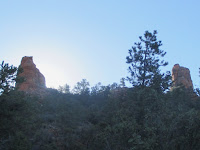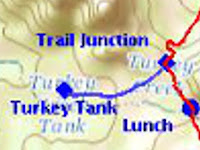Fifteen
Skyliners hiked on Yeager Mine Trail on 27 February 2016. The day
was perfect for hiking, with the merest dusting of wispy clouds on
the far horizon. We left the Cottonwood Safeway parking lot just a
couple of minutes after 0800 and headed across the mountain,
traveling south on Hwy 89A. About 21.3 miles from the parking lot,
we turned left onto a dirt road. This road is identified as Forest
Road Road 643 on the Motor Vehicle Use Map1
but as Forest Forest Road 151 on another Prescott National Forest
map2.
It may also be referred to as Powerline Road. In any case the first
0.9 miles of the road, to the junction with FR 9002S (Yeager Mine
Road), is heavily traveled and maintained in excellent condition.
At
the Yeager Mine Road turnoff we found the following signage.
 |
| Signs posted at the Yeager Mine Road turnoff |
The
Mingus Mountain Academy sign shown in the photograph (above)
elicited some curiosity and after a little research I found it
describes itself as a “residential
treatment center for emotionally and behaviorally at-risk adolescent
girls.” The mountain
lion shown on the sign is the symbol of “a
student-run organization, similar to a high school student
government.”
I
have never actually visited there but the campus looks quite
impressive from afar. The below photograph was taken at a distance
from Forest Road 643, perhaps half a mile south of the sign.
 |
Mingus Mountain Academy – photographed from FR 643 on 20 February 2016
|

Forest Road 9002S
(Mingus Mine Road), although less well-maintained than the dirt road
from Hwy 89A had been was still navigable by passenger cars for the
first 0.3 miles. We then came to a fork in the road with a sign
(right) indicating that Mingus Mine Road veered off to
the left and became a private road. We still had not reached the old
Yeager Mine site and according to the maps I consulted in planning
this hike, the forest road continues well beyond that point. That
could only mean that Mingus Mine Road and the forest road split at
this point with FR 9002S continuing straight ahead.
However, I had scouted
the area earlier and noted that the road ahead, although still
suitable for 4-wheel drive vehicles, was quite rough. In addition,
a trail sign (left) at the fork
indicated that Trail 501 (Mingus Mine Trail) started there. I had
been surprised at finding the sign at that spot because all of my
maps showed the trail starting about 0.8 miles ahead at the end of FR
9002S.
Parking where the
private road branched off, we hiked 140 yards up the forest road to
the old Yeager Mine site for a group photograph.
Yeager
Mine was an
underground Cu-Au-Ag mine, owned by the Shannon Copper Company, and
was in production during the period 1890-1949. “Workings
included an inclined shaft to the 1300 level, drifts extending mostly
to the East a maximum of 750 feet. Production was 9,627,987 pounds of
Cu; 2,466 oz. Au; and 77,134 oz. Ag (to 1919). Additional 800 tons of
Cu-Ag ore in 1922”3.
Little is left of the
Yeager Mine site, just some indentations in the earth and a few
battered found-ations where massive machinery once stood (right).
The shafts have been filled in for safety reasons and the slag piles
have largely been flattened and eroded so as to largely blend into
the terrain.
From just above the
mine we could look back across it and on across Prescott Valley to
the mountains beyond.
 |
| Looking across Prescott Valley, Yeager Mine is visible at left (see bare spot) |
After visiting the mine
we trudged on up the forest road, crossing a property boundary line
and entering Prescott National Forest. We passed the remnants of an
old abandoned dwelling with associated outbuildings on our right and,
just across the road from it, what appeared to be a old filled-in
prospect site.
About 0.8 miles after
leaving Yeager Mine we came to a fork in the road. The road to the
left was quite distinct and appeared to be fairly well traveled. The
right fork (red arrow below),
showing less sign of travel, led straight up the spine of a ridge
that separated two washes.
 |
| The arrow just above the resting hiker points to the correct trail |
This is the point
where, according to my reference maps, FR 9002S ends and Yeager Mine
Trail starts. A Trail # 501 sign (left)
was posted to show the way and this sign, unlike the one we had seen
at Yeager Mine, prohibited all but hikers, equestrians and mountain
bikers. Jeeps, ATVs and other motorized vehicles are prohibited.
However, someone has pretty well obliterated the part of the sign
that prohibits ATVs. There is left only a faint end of the red line
that ran through through the ATV symbol.
Another
0.4 miles, consisting of a steep 400-foot climb along the spine of a
ridge, brought us to the junction of a short side trail that leads to
Tunnel Spring. I had noted this spring on the map and was determined
to explore it. The distance to the spring turned out to be about 0.1
mile and the first 100 yards was wide, clear and easy to hike. The
rest of the trail was a little overgrown in a few spots but never
difficult to follow. What we found when we arrived was a seep
spring. A closer examination indicated that the seep had at some
time in the past been dug out by tunneling into the side of the
mountain and a pipe had been inserted to channel the flow of water
into a series of narrow watering troughs. Although water no longer
flows from the pipe (below
right) and the troughs (below
left) are now empty and discarded, there is
enough left to tell the story of what once was.

We paused for a short
time at the spring before returning to the main trail to resume our
sharp climb up the mountain. On the way out I stopped to photograph
two of our hikers (right) making
their way through the most overgrown portion of the short Tunnel
Spring Trail.
Back at the main trail
we took a head count and found that we were missing a hiker. This
had so far been an easy-to-follow trail except for the single
somewhat confusing spot where the trail had turned up the ridge spine
between washes. We had thus not worried too much about being a bit
spread out. Now, we were in a quandary. Had the missing hiker gone
ahead, had he turned back or had he wandered off the trail for some
unknown reason? We called his name, sent a hiker back to the spring
to look for him and sent people ahead to see if he had continued up
the trail. Finally, we found that he had turned back without telling
anyone when he reached the overgrown section of Tunnel Spring Trail
and, rather than wait for the group, had continued on up the trail by
himself.
While
waiting for our lost hiker to be found, I took a series of
photographs that I could stitch together for a panoramic view across
the valley from the trail junction, an elevation of 6340 feet.
 |
| View from the junction of Mingus Mine Trail and Tunnel Spring Trail |
Once we were all back
together we headed on up the trail for lunch at a saddle above Mingus
Springs. To reach there we hiked another 0.7 miles and climbed about
another 450 feet, ending at an elevation of 6893 feet. I found a
sunny spot with a cushion of grass and had a nice long nap after
lunch.
Someone asked whether
it would be possible to access the upper Yeager Mine Trailhead by
vehicle. The answer is yes with a caveat that the last 0.7 miles
requires a 4-wheel drive vehicle. I had, as a matter of fact, done
just that last November. It is therefore possible to position
passenger vehicles at both ends and hike this trail one way. This
would be a short hike of only 3.2 miles. That distance would include
the 0.7 miles required to reach the upper trailhead from a place
where a passenger vehicle could be parked as well side trips to
explore Tunnel Spring and Yeager Mine.
To reach the upper end
of the trail by passenger vehicle from the Cottonwood Safeway parking
lot (map below), travel south on
Hwy 89A for 15.2 miles, turn left onto Forest road 104 and go 1.5
miles, turn right on FR 413 and go 2.3 miles, turn right on FR 132
and go 0.4 miles then turn right onto FR 105 and go 0.7 miles and
park at the intersection with FR 9626A. From there it is another 0.7
miles by foot or by 4-wheel drive on FR 9626A to the upper Yeager
Mine Trailhead.
 |
| How to access the upper Yeager Mine Trailhead by road |
On the map shown below
the two short sections of blue track at either end of the trail (red
track) are the forest service roads by which Yeager Mine Trail may be
accessed. The road accessing the lower end of the trail is Forest
Road 9002S and the one accessing the upper trailhead is Forest Road
9626A. The lower trailhead is accessible by passenger vehicles; to
access the upper trailhead, passenger vehicles should be parked at
the junction of FR 105 and FR 9626A. From there it is only 0.7
miles by foot or 4-wheel drive to the trailhead.
For the lower end of
the trail, the map shows a “new trailhead” and an “old
trailhead”. The old trailhead is where all the maps I found
indicated the trail started; the new trailhead is where we found the
first posted sign indicating that we were on Trail 105 (Yeager Mine
Trail).
The red track on the
map shows our track on the way up the trail and includes side trips
to the old mine site and to Tunnel Spring. It measures 2.5 miles in
length. Our return journey, without the two side trips, was shorter
and the entire hike measured only 4.3 miles. The highest elevation
was 6893 feet and the total ascent was 1365 feet.
1Motor
Vehicle Use Map, Prescott National Forest, 01 August 2012
2Prescott
National Forest “map”, published 1993, revised in 2000
3
http://www.mindat.org/loc-41726.html







































